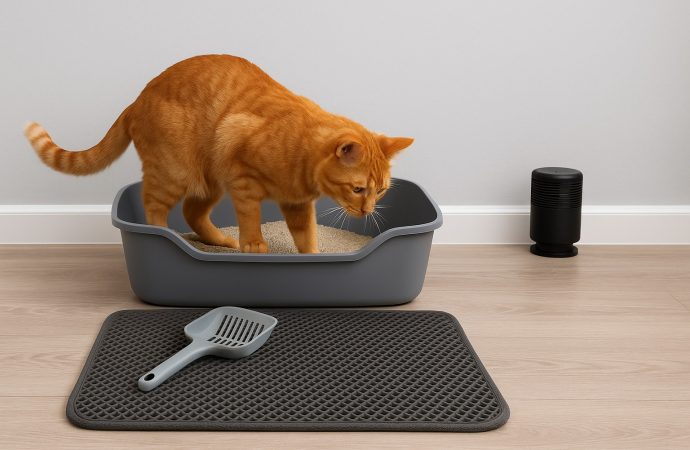Cats are known for being clean animals, but anyone who’s owned one knows that their litter area can quickly become the most unpleasant part of the house. From lingering odors to scattered litter, maintaining a clean and fresh litter space is essential not just for your comfort, but also for your cat’s health and happiness.
Cats are known for being clean animals, but anyone who’s owned one knows that their litter area can quickly become the most unpleasant part of the house. From lingering odors to scattered litter, maintaining a clean and fresh litter space is essential not just for your comfort, but also for your cat’s health and happiness.
Whether you’re a new cat parent or a seasoned feline fan, here are some easy, practical ways to keep your cat’s litter area tidy, odor-free, and inviting — both for you and your furry friend.
Why a Clean Litter Area Matters
Cats are notoriously picky about cleanliness. If their litter box is dirty, they may start eliminating outside of it, leading to accidents on furniture or flooring. A clean space reduces odor, minimizes bacteria, and keeps your pet stress-free. It also makes your home more pleasant and helps avoid the buildup of harmful germs that can affect both pets and humans.
1. Scoop Daily (Yes, Every Day!)
One of the most basic but important habits is daily scooping. Remove waste at least once a day — twice if you have multiple cats. A clean box encourages proper use and minimizes odors. Cats prefer a clean space to do their business, and they may begin to avoid the box if it’s not up to their hygiene standards.
Pro Tip: Use a scoop with a fine mesh and a comfortable grip to make the task easier. Scoopers are among the simplest but most essential cat litter accessories.
2. Use the Right Type of Litter
Not all cat litters are created equal. Some are better at controlling odor, while others clump more effectively. Consider the following when choosing litter:
- Clumping vs. Non-Clumping: Clumping litter makes scooping easier and helps reduce odors.
- Scented vs. Unscented: Scented litters can help mask odors but might be off-putting to some cats.
- Natural Alternatives: Litters made of corn, walnut, or recycled paper are environmentally friendly and often less dusty.
Try different types until you find one that satisfies both you and your cat.
3. Wash the Litter Box Weekly
Even with daily scooping, waste and bacteria can build up on the box itself. Once a week, empty the entire box and wash it with mild soap and warm water. Avoid strong-smelling cleaners like bleach or ammonia, which can repel cats.
Make sure to thoroughly dry the box before refilling it with fresh litter. Some cat parents even use disposable litter box liners for easier cleaning.
4. Replace Litter Frequently
While daily scooping helps, the entire litter should be changed out periodically. Depending on the type of litter and the number of cats in your home, full replacements may be needed every 1–2 weeks. This not only helps with odor control but also keeps the box sanitary.
5. Use High-Quality Litter Mats
Cats often track litter outside the box, which leads to a messy and gritty floor. A good litter mat placed outside the box can catch most of these particles. Choose a mat that is:
- Easy to shake or vacuum
- Textured to trap litter
- Comfortable on your cat’s paws
Mats are an underrated but powerful part of your cat litter accessories toolkit.
6. Invest in Covered or Self-Cleaning Boxes
Covered litter boxes can help contain odors and prevent litter from being kicked out, especially if your cat is a digger. However, not all cats like enclosed spaces, so it’s best to introduce it gradually.
If budget allows, automated self-cleaning litter boxes are a game-changer. These smart devices scoop waste into a sealed compartment after each use, drastically reducing odor and mess. It’s one of the best cat litter accessories you can add to your home if convenience and cleanliness are priorities.
7. Add Baking Soda for Odor Control
Sprinkling a thin layer of baking soda at the bottom of the litter box before adding fresh litter can help neutralize odors. Baking soda absorbs moisture and prevents that lingering “cat box smell” without being overpowering to sensitive feline noses.
8. Ventilate the Litter Area
Place the litter box in a well-ventilated area. Avoid small, enclosed spaces like closets or cabinets unless they have adequate airflow. A small fan or an open window nearby can help disperse odors.
9. Keep Litter Supplies Organized
Set up a litter cleaning station near the box. Use a small shelf or basket to store extra liners, scoops, disposable gloves, trash bags, and disinfectant wipes. This makes daily and weekly maintenance quicker and more efficient.
Storage bins and containers designed for litter maintenance are among the most practical cat litter accessories available online
10. Try Odor-Eliminating Sprays and Air Purifiers
There are many non-toxic sprays designed specifically to neutralize litter box odors. Spray them lightly in the air (not directly into the box) to freshen the space. You can also place a small pet-safe air purifier near the litter area to keep the air clean and allergen-free.
11. Use Multiple Litter Boxes
If you have more than one cat, the golden rule is one litter box per cat, plus one extra. This reduces competition, prevents accidents, and helps spread out the use so no one box becomes overfilled too quickly.
12. Choose the Right Location
Place litter boxes in quiet, low-traffic areas where your cat feels safe and won’t be disturbed. Avoid placing them near food or water bowls. Also, ensure easy access, especially for senior cats or kittens who might struggle with stairs.
13. Monitor for Behavior Changes
If your cat suddenly stops using the litter box, it may be a sign that something is wrong — either with the litter area or their health. Cleanliness is important, but behavioral cues can also point to stress, infections, or other medical issues.
14. Switch Things Up Slowly
Cats are creatures of habit. If you’re planning to upgrade to new litter, switch brands, or try a new box type, introduce the change gradually. Mix old and new litter for a few days or place the new box next to the old one until your cat adjusts.
Final Thoughts
Keeping your cat’s litter area fresh and clean doesn’t have to be a chore. With the right routine, a few smart tools, and the best cat litter accessories, you can make it a low-maintenance, odor-free zone that works for both you and your pet.
Not only does a clean litter area encourage better hygiene, but it also improves your cat’s overall well-being and strengthens the bond between pet and parent. Invest in quality accessories, maintain a consistent cleaning schedule, and your home will smell fresher — and your cat will thank you for it.
FAQs
How often should I clean my cat’s litter box?
You should scoop waste at least once daily and wash the box with soap and water once a week. Replace the entire litter every 1–2 weeks depending on usage and litter type.
What is the best way to reduce cat litter odor?
Daily scooping, using clumping or odor-neutralizing litter, adding baking soda, and placing an air purifier nearby are effective ways to reduce odors.
Are covered litter boxes better?
Covered boxes can reduce litter mess and contain odors, but not all cats like them. It depends on your cat’s comfort and preferences.
How many litter boxes do I need for two cats?
The rule of thumb is one box per cat, plus one extra. For two cats, aim for three litter boxes.
What are must-have cat litter accessories?
Must-haves include a sturdy scoop, odor-control litter, a litter mat, storage containers, and possibly a covered or self-cleaning litter box for added convenience.
Read more: Crafting Balanced Diet Plans for Senior Pets in 2025
















